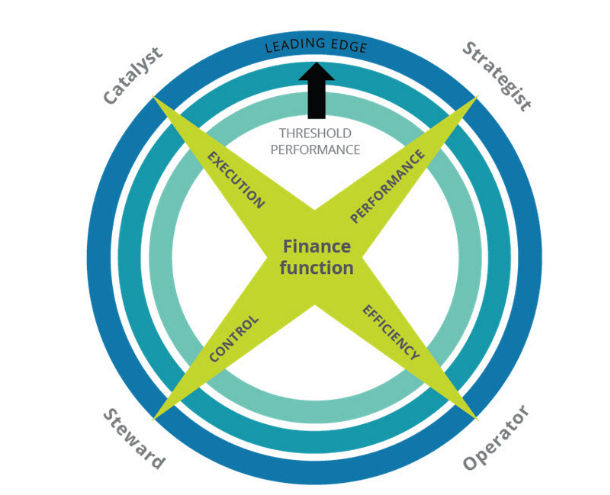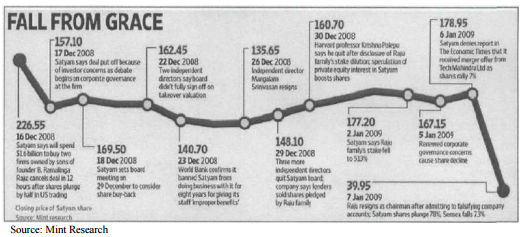Corporate Ethics in Action- The Infosys and Satyam Case Study

This article examines the contrasting corporate governance practices of Infosys and Satyam, highlighting how ethical financial leadership fosters trust and sustainability, while fraudulent practices lead to corporate downfall. It underscores the critical role of CFOs in ensuring financial transparency, investor confidence, and long-term success.
1st Nov 2018
Comparative Analysis of Infosys and Satyam: Corporate Governance and Financial Leadership
Corporate governance plays a critical role in shaping an organization’s success, sustainability, and credibility. The contrast between Infosys and Satyam highlights the impact of ethical leadership, financial stewardship, and governance structures on corporate integrity and investor confidence.
Role of CFOs in Corporate Governance

As highlighted by James Riley, an effective CFO must be an integral leader in the organization, working closely with the CEO while balancing the dual responsibilities of stewardship and business partnership. The CFO is not merely a financial expert but a strategic driver ensuring sustainable value creation, governance, and financial transparency. This principle is evident in the contrast between Infosys’ T.V. Mohandas Pai and Satyam’s Vadlamani Srinivas.
T.V. Mohandas Pai: The Ethical and Strategic CFO of Infosys
Infosys’ former CFO, T.V. Mohandas Pai, played a significant role in ensuring financial transparency, investor confidence, and sustainable growth. His leadership was characterized by:
- Articulating clear financial policies to guide Infosys' growth.
- Enhancing transparency and disclosure mechanisms to build investor trust.
- Creating a robust financial model to meet growth and profitability challenges.
Pai’s efforts earned him recognition as India’s Best CFO in multiple industry polls, reinforcing Infosys’ reputation for ethical governance and financial discipline.
Vadlamani Srinivas: The Complicit CFO of Satyam
On the other hand, Vadlamani Srinivas, the then CFO of Satyam, was complicit in financial fraud, prioritizing the interests of the company’s chairman over ethical leadership. His actions included:
- Actively aiding in falsifying accounts and fabricating records.
- Creating 10,000 fake jobs to siphon approximately INR 20 crore per month.
- Selling 92,358 shares of Satyam ESOPs just months before the scam surfaced, raising suspicions of insider knowledge.
Srinivas’ failure to maintain financial integrity contributed to the Satyam scandal, an event that remains one of the biggest corporate frauds in India’s history.
Corporate Governance Framework: Infosys vs. Satyam
1. Board Composition and Independence
Infosys:
- Maintained a well-structured board with independent directors.
- Adopted a transparent decision-making process.
- Ensured stringent financial reporting and audits.
Satyam:
- Had a board dominated by family and close associates, reducing independence.
- Lacked transparency, enabling fraudulent practices to go unchecked.
- Engaged in manipulative accounting and unethical financial reporting.
2. Ethical Leadership and Corporate Responsibility
Infosys:
- Focused on corporate governance as a strategic advantage.
- Implemented strict financial policies and compliance mechanisms.
- Developed a culture of accountability and corporate responsibility.
Satyam:
- Engaged in systematic fraud, prioritizing short-term financial manipulation.
- Lacked checks and balances to prevent executive misconduct.
- Ultimately lost investor confidence, leading to its downfall.
Comparison of Corporate Governance: Infosys vs. Satyam
Infosys: A Model of Transparency
Infosys has long been regarded as a benchmark for corporate governance in India. The company adopted the U.S. Generally Accepted Accounting Principles (GAAP) years before most Indian companies. Some of its governance practices include:
- Transparency in Financial Disclosures: Infosys provided detailed stock market price information and adhered to stringent accounting standards.
- Commitment to Ethics: Narayana Murthy emphasized ethical conduct, fairness, and a distinction between personal and corporate finances.
- Independent Board of Directors: Infosys maintained a well-structured, independent board ensuring accountability and strategic oversight.
- Credit Ratings & Risk Management: Infosys maintained a debt-free policy, ensuring financial stability and earning high governance ratings from CRISIL since 2004.
Satyam: A Case of Corporate Misgovernance

Satyam’s governance structure was deeply flawed, leading to one of India’s biggest corporate frauds. Governance failures included:
- Lack of Transparency: Satyam manipulated its balance sheets, overstating profits and falsifying financial statements.
- Weak Oversight by the Board: The board failed to question management strategies, allowing fraudulent activities to continue unchecked.
- Conflicted Leadership: CEO Ramalinga Raju and his brother, who also served on the board, had excessive control without independent oversight.
- Unethical Practices: The company engaged in bribery, insider trading, and data theft, leading to its blacklisting by the World Bank.
Role of CFO in Satyam Accounting Scam
The Chief Financial Officer (CFO) of Satyam, V. Srinivas, played a crucial role in facilitating fraudulent financial activities, including:
- Unethical Conduct: There was no ethical code guiding financial decisions, leading to widespread corruption and malpractice.
- False Accounting Entries: The CFO manipulated financial records, fabricating non-existent accrued interest and inflated profits.
- Lack of Auditing Integrity: Satyam’s external auditor, PricewaterhouseCoopers (PwC), failed to detect or report discrepancies.
- Facilitating Insider Trading: Promoters sold 3.9 crore shares, collecting over Rs. 3,029 crore based on falsified financial health indicators.
Impact of the Scam on Stakeholders
The Satyam scandal had severe consequences for multiple stakeholders:
- Shareholders: Satyam’s stock price crashed from over Rs. 200 to Rs. 11.50 within days, wiping out shareholder wealth.
- Employees: Thousands of employees faced job insecurity as the company struggled to survive.
- Clients & Business Partners: Clients lost trust, and contracts were reassessed or terminated.
- Regulators & Market Sentiment: The scam exposed weaknesses in India’s corporate governance framework, leading to regulatory reforms like the Companies Act 2013.
Lessons from the Infosys-Satyam Contrast
To prevent future corporate frauds, companies must:
- Strengthen Board Independence: Board members should be independent, proactive, and vigilant.
- Enhance Auditor Oversight: External auditors must be rotated regularly to prevent conflicts of interest.
- Promote Ethical Leadership: Executives must uphold integrity, transparency, and fair corporate practices.
- Encourage Shareholder Activism: Investors must actively question governance practices to hold management accountable.
Conclusion: The CFO as a Pillar of Governance
A CFO must act as:
- An organizational leader, ensuring financial sustainability.
- A strategic partner, guiding value creation and risk management.
- A governance steward, upholding regulatory and ethical standards.
- An integrator, aligning financial strategies with business objectives.
The Infosys-Satyam case study reinforces that a company’s financial leadership directly impacts its long-term viability.